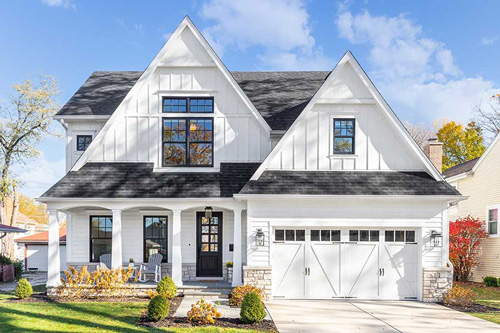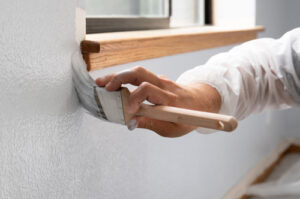
Boosting your property’s value is a common objective for homeowners. Whether you have future plans to sell your home or simply desire a more valuable asset, harnessing the transformative power of paint can be a cost-effective and impactful strategy. In this article, we will delve into the steps required to elevate your home’s worth through the art of painting.
Understanding Paint’s Influence on Home Value
Understanding the impact of paint on your home’s value is crucial. Studies consistently show that a fresh coat of paint can significantly increase a property’s market worth. Beyond numbers, paint enhances curb appeal, making your home more appealing to buyers and creating a positive first impression. The choice of color and the paint’s condition are pivotal in determining your home’s overall appeal and, ultimately, its value.
Selecting The Ideal Paint Colors
Different colors evoke diverse emotions and atmospheres. When determining which colors to employ in your home, take into account the following considerations:
- Understanding Color Psychology: Conduct research on the psychological impact of colors to select hues that evoke the desired ambiance within each room. For instance, gentle, neutral tones can engender a more open and welcoming atmosphere.
- Timeless vs. Fad Colors: While trendy colors may appear appealing at present, they are susceptible to falling out of fashion rapidly. Opt for timeless colors that will maintain their appeal over the long haul.
- Harmonizing with Architectural Style: Factor in your home’s architectural design when selecting colors. A Victorian-style home may necessitate different color choices than a modern, minimalist structure.
Preparing Your Residence for Painting
Prior to embarking on your painting project, it’s imperative to adequately prepare your home. This entails:
- Inspection: Examine interior and exterior surfaces for damage and wear, noting areas needing repair before painting.
- Repairs: Fix structural issues, cracks, and damaged surfaces to prevent paint problems and further damage.
- Cleaning & Preparation: Thoroughly clean surfaces, removing dirt and grease. Proper prep, including sanding and priming, ensures a smooth, lasting finish.
Choosing Top-Quality Paint and Materials
Investing in superior-quality paint and materials is essential for a successful painting endeavor. Consider the following factors:
- Paint Types: Pick the right paint for the surface – interior and exterior paints have different properties.
- Finish Selection: Match the finish (matte, satin, or semi-gloss) to the room’s use; prioritize durability for exteriors.
- Quality Tools: Invest in top-notch brushes, rollers, and equipment for a professional result.
DIY vs. Hiring Professionals
The decision of whether to undertake the painting project independently or engage professional painters bears significant weight. Each option boasts its advantages and drawbacks:
Advantages of DIY Painting:
- Economical savings on labor costs.
- Personal gratification and control over the project.
- Flexibility in scheduling.
Benefits of Employing Professional Painters:
- Profound expertise and experience.
- Time-saving benefits.
- Access to professional-grade equipment.
- Assurance of a high-quality finish.
Best Practices for Effective Painting
Whether you opt for a do-it-yourself approach or enlist professionals, adhering to best practices is imperative for a successful outcome:
- Interior Painting Techniques:
- Start with preparatory work, including hole-filling and surface sanding.
- Administer a coat of primer to bolster adhesion and ensure uniform color.
- Use steady, consistent strokes during paint application and sustain a wet edge to avert noticeable brush marks.
- Exterior Painting Techniques:
- Cleanse and prepare the exterior surface, including scraping and sanding as needed.
- Account for weather conditions and circumvent painting in excessively hot or cold conditions.
- Administer paint uniformly, working from top to bottom to forestall drips.
Incorporating Accents and Details
To elevate your home’s value through painting, contemplate incorporating accents and embellishments that accentuate its architectural elements. This may encompass painting trim, doors, shutters, and other features in complementary colors. Such enhancements can set your home apart and forge a lasting impression.
Maintaining Your Painted Surfaces
Following the investment of time and effort into painting your home, maintaining the painted surfaces becomes paramount. Regular cleaning, examination, and touch-up work are indispensable for preserving the freshness of the paint and averting deterioration. Promptly address common paint issues, including peeling, fading, or chipping, to safeguard your property’s value over time.
Increase Your Home’s Value with Revel Painting
Painting is a wise and cost-effective investment to boost your home’s value. Careful color selection, thorough surface preparation, quality materials, and best practices can transform your home’s appearance and increase its market worth.
Whether you’re selling or enhancing your living space, a fresh coat of paint can achieve your goals. So, grab those paintbrushes and start your home improvement journey today!
Considering a painting project for your home or business? Contact Revel Painting for top-notch residential and commercial services. Our experienced team provides exceptional results and customer service. Schedule a free consultation at 612-345-9136!






